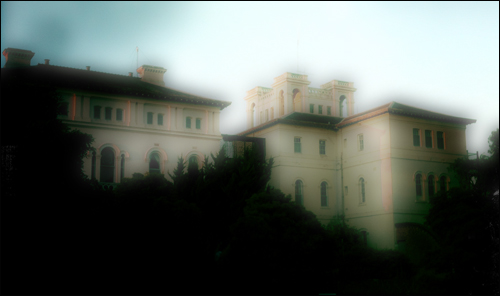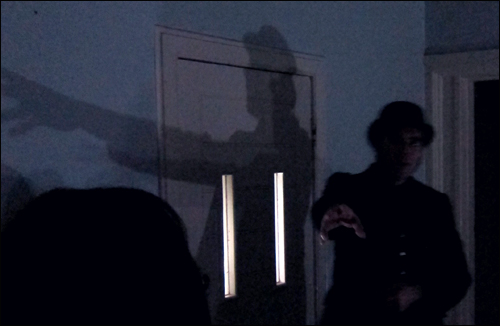Thu 12 Dec 2013
Festive Language
Posted by anaglyph under Signs, Stupidity, Tragedy, Words
[5] Comments
Thu 12 Dec 2013
Posted by anaglyph under Signs, Stupidity, Tragedy, Words
[5] Comments
Wed 9 Jan 2013
Posted by anaglyph under Australiana, Creepy, Insane People, Strange Lands, Tragedy
[7] Comments

Late last Saturday evening, Violet Towne and I spent several hours in an abandoned lunatic asylum. Now I know there are those among you who will feign surprise that this is anything out of the ordinary (I’m looking at you, Queen Willy) but it has been, in fact, nearly 25 years since my last Abandoned Lunatic Asylum Adventure.
The place we visited is called Aradale, formerly Ararat Lunatic Asylum, one of three asylums built in southern Australia in the late 1800s for the express purpose of accommodating ‘the growing number of ‘lunatics’ in the colony of Victoria’. Aradale is set on a small hill overlooking the Victorian country town of Ararat, a former goldrush settlement which now sports a population of about 7000 people. It’s about an hour’s drive to Ballarat, the nearest center of any significant size, and a further two hours to Melbourne.
Aradale offers three types of tours: a standard historical tour by the volunteer group The Friends of J Ward, ((J Ward is an annexe of Aradale, and is a goldrush-era high security prison that was seconded by Ararat Asylum in the 1880s as a repository for its ‘criminally insane’ inmates. It can be found in the town of Ararat, a few kilometers from Aradale. VT and I did the historical tour of J Ward on the morning after our Aradale visit. It’s also quite a grim and amazing place.)) and a ‘theatrical ghost tour’ and a ‘ghost hunting tour’ run by a company called Australian Ghost Adventures
I am, as you know dear Cowpokes, quite skeptical of all things ‘haunted’, but I’m nevertheless partial to a bit of gothic fun, so VT and I nixed the straight historical tour in favour of one of the more ghostly options. Since the ghost ‘hunting’ tour sounded like it might attract the same kind of loonies formerly housed in the asylum, ((The ghost hunting tour offers all the technical accoutrements that have become associated with this contemporary folly – night-vision cameras & goggles, EMF detectors (which may as well be called WTF detectors), spirit boxes (more on those in an upcoming post), air temperature monitors and all manner of other nitwittery. It was also about four times as expensive as a result.)) the ‘theatrical’ affair seemed the best bet.
In the end, it was a great choice. After leaving our motel at around 9pm (where the manager warned us that she’d once hosted a ‘total skeptic’ who was ‘completely converted’ after his visit to Aradale…) ((A claim which I took with a large grain of scoff.)) we headed out to the asylum and up the suitably forbidding yew-lined driveway.
At the door of Ararat Lunatic Asylum, we were greeted by a chap in funereal attire who enquired ghoulishly after our health, and effusively espoused the benefits of the hospital’s location, situated as it is in such a way on the hill as to take the maximum advantage of ‘the cleansing airs’ (a contrivance in keeping with the prevailing wisdom of Victorian mental health practice). He told the assembled group that, in the manner of the historical facts accumulated from patient records in Victorian asylums, about two thirds of us would be able to leave the hospital at the end of the evening, but that one third would be staying for the rest of their lives. ((He neglected to mention at this time that a good number of the patients who left the hospital prematurely did so in pine boxes…)) The ensuing two-hour tour continued in a similar manner, with our guide proving to be an entertaining raconteur as he led us up corridors and down stairways by lantern light, through the length of the shadowy and labyrinthine edifice.

I fear that it wasn’t the terrifying and ghastly ordeal that some of our party expected, but for me the blend of tempered gallows humour and well-researched historical detail was just about right. I must confess that I was expecting probable episodes of faux haunting, but none eventuated, and the only notable ‘scares’ came from our guide when he appeared cadaverously from the shadows in some unnoticed nook in the corridor. The building itself was the star of this show, and those who really wanted to see ghosts almost certainly went away thinking they had. ((At one stage, two impressionable women on the tour were besides themselves when they noticed a ‘chill breeze’ on their legs. Yes ladies – that would be the cool wind from outside blowing under the door into the warm room we were in…))
Places like Aradale are, as I’ve mentioned previously on The Cow, among the creepiest and most disturbing structures on the planet, when you consider the thousands upon thousands of suffering souls who once wandered their dark and echoic corridors. No-one needs to do much to make a tour through them a very memorable and unsettling experience.
It was pretty gloomy for most of the time we were inside the hospital, ((Outside, by contrast, the skies were ablaze with the most incredible starry vistas I’ve seen in ages.)) so I wasn’t able to get many good interior shots of our adventure, but there are some nice photos of the rooms and halls of Aradale on the Aradale Ghost Tours site.
And while we’re on the subject of lunatic asylums, if you’ve never heard the story I referred to up in the first paragraph, of how I was lost, by myself, in the middle of the night in an abandoned asylum in London, it’s here (and even for those of you who do know it, it’s worth a revisit – I’ve updated that post to include some more information about Stone House Asylum, and I’ve linked to an UrbEx site that has an enormous and beautiful gallery of interior photographs).
Thu 6 Sep 2012
Posted by anaglyph under Australiana, Daft Advertising, Food & Drink, Photography, Tragedy, Travel
[12] Comments
A little while ago, Violet Towne and I drove up to Sydney as we sometimes do. It’s about a ten hour trip and we’d usually make it in a day, but this time we decided to break it by leaving on Friday night, driving for a few hours and stopping on the way at at a motel at which we’d made an online reservation. To save the proprietors from embarrassment, I’m not naming names, or even putting a pin on the map, but suffice to say the place we chose was a sizeable establishment in a largish country centre with more than enough reason to know what constitutes modern expectations of hospitality. Somehow or other I ended up on their mailing list. I’m not really sure how this happened, as I’m usually fastidious about not handing out my personal email address unless it’s absolutely necessary. I suspect that they got it through the online booking form, even though I opted out of any email ‘notifications’ as I always do.
Whatever, I know they now have my details, because this morning I got a cheery update from them, espousing the wondrousness of their restaurant’s new menu. Viz:
Bonzo’s ((Name altered to protect the innocent.)) Restaurant & Bar has recently launched the new menu with brand new dishes created by Head Chef, Hattie Bonilla ((Ditto.)) and her team with an emphasis on The Grill. The Grill has a big variety of steaks in all sizes and cooked to your liking with your choice of sides and sauces to provide you with the ultimate meal.
Then follows what we must assume is meant to be a pictorial representation of ‘the ultimate meal’ (completely unaltered from how it appeared in the email):

Oh, my absinthe-addled one-legged maiden aunt. Could they possibly have made something look any less appetizing? This must surely be the best example I have ever seen of what NOT to do when photographing food. Here at the cusp of the visually hip 21st Century I find it almost impossible to believe that anyone could achieve anything quite so awful unless they actually set about it intentionally. Why, even the average iPhone meal snap looks tastier (and more professional) than this.
These two blobs of anonymous meat cuts, flanked by iridescent plasticized broccolini and a smear of… what is that – industrial sealant? Baby poo? – served up on a medical specimen tray and bleached out by a blinding flash of light on a morgue table are less a depiction of a tastebud temptation than a snap from a crime scene. And for Christ’s sake – how about a second shot to at least get the whole thing properly framed? It’s not like it will cost you anything!!!
Tue 29 Nov 2011
Posted by anaglyph under Hokum, Scary, Skeptical Thinking, Stupidity, Tragedy, WooWoo
[18] Comments

Sometimes, Faithful Acowlytes, teh stoopid in the world overreaches itself and becomes just plain criminal. Today, as Exhibit 1, I give you:
No, dear friends, this is not some kind of Tetherd Cow parody of the worthy and quite awesome Médecins Sans Frontières, although it’s so fuckin’ unbelievable that it’s hard to accept that it’s anything but a cruel prank. Yes, you understood it correctly: these are homeopaths who model themselves on Doctors Without Borders ((Although they make it VERY clear on their site that they are in no way affiliated with that organization. One speculates that you don’t put a notice like that on your front page unless someone compels you to do so…)) and travel to poor countries like Haiti to spread useless superstitious nonsense based on the brainless ‘medical’ intuitions of an 18th century German village doctor. This, to my mind, is a tragedy of vast proportions.
Volunteers Sally Tamplin, Holly Manoogian and Alyssa Wostrel traveled to Port-au-Prince on May 23 and returned home on June 3, participating in the longest, most intense undertaking in that country by HWB. Responding to requests by charitable groups in Haiti, the volunteers worked not only in the capital but also traveled to sites in the countryside. Their ten-day schedule was a whirlwind of compassionate homeopathic intervention.
Intervention? What – they were visiting sick Haitians with poor access to medical care and substituting no medical care at all? Yeah, that’s what I call intervention, alright, although I fail to see where the compassion comes in.
When I see the pictures of middle-class white women (they are mostly women, it seems) on this site smiling and hugging little black kids, it makes me furious. I know they are probably all just misguided and good-intentioned and even believe that what they are doing is helpful, but I just want to point something out here: people in places like Haiti who are in desperate need of good medical care look at these healthy, rich Americans and trust them to be bringing that same standard of health to their own country. These borderless homeopaths, however, didn’t come by the possession of their good health via superstitious nonsense. They are healthy solely because of science; science that improved their knowledge of nutrition; science that gave them a good understanding of hygiene; science that made childbirth relatively safe; science that gave them immunity against polio and measles and smallpox and tuberculosis; ((Although science is losing that battle somewhat as TB rapidly evolves to become resistant to antibiotics.)) science that allows their society to understand insect-borne diseases and keep them under control. And let’s be clear here: there is NO science in homeopathy. None. When one of these homeopaths contracts a serious infection back home in their own wealthy country, they don’t treat it with some silly sugar water potion. If they do, they die. These privileged people have become so ignorant of the powerful scientific basis upon which their standards of health are built, that it has become completely transparent to them. They apparently think they are healthy just because.
As I contemplate this situation, though, I strangely begin to find myself in agreement with one of the basic notions of homeopathy. According to homeopathic beliefs the more dilute a homeopathic remedy is, the more powerful its effects – as I’m sure you already know. I propose, then, that Homeopaths Without Borders act on this basic tenet of their practice. Let’s say one homeopath leaves Haiti- surely the positive effect of Homeopaths Without Borders on the Haitian people increases. If a few more leave, the beneficial effects become stronger still. And if we really ultra-dilute the pool and ALL homeopaths leave Haiti, then I think you’d agree that they would be doing the most good they could possibly do.
Let’s see if they can fault the logic in that argument…
Sun 28 Nov 2010
Posted by anaglyph under Gadgets, Hokum, In The News, Skeptical Thinking, Stupidity, Tragedy, WooWoo
[6] Comments

I don’t know about you, but when I read things like the above snippet from the Austin Business Journal, ((Notice how uncritically the ABJ just spouts the guff about the ShooTag ’emitting an electromagnetic frequency’ (and the rest of ShooTag’s completely unsubstantiated pseudoscience). It does nothing of the sort, of course, but this is how pieces of unfettered stupidity get lent ersatz credibility. Shame on you Christopher Calnan. Do some research before you spout such rubbish!)) my blood boils. There is a tendency, when it comes to silly pseudoscientific beliefs, for people to say ‘Well, OK, but what’s the harm?‘ I probably don’t even need to elaborate on what the harm is for a nation of poverty-stricken desperate people who face the very real possibility of death from mosquito-borne diseases.
In case it’s not obvious, let me simplify what is going on here: ShooTag is, in the name of ‘charity’, ((…and a little bit of advertising doesn’t go astray…)) sending bits of plastic that cost nothing and do nothing, to a country in dire need of real help. In addition, they are almost certainly displacing effectual disease-control methods by foisting their useless garbage on uneducated people whose lives depend on proper scientific medicine. The only thing for which we can be thankful is that they sent so few of the damn things. I mean, seriously – a hundred of each? What would that be in actual manufacturing cost? Say (generously) ten cents per tag… wow, 20 bucks. It gives a new definition to the word ‘cheap’. The ShooTaggers are, in fact, doing less than the average school kid who sent some pocket money to the Haiti Red Cross appeal. You really have to question their motives with such a flimsy gesture.
I note in passing that Mission Life International, the company distributing the ShooTags, is an organisation that appears to specialize in providing aid through the proselytisation of chiropractic, another flavour of pseudoscience that we haven’t, as yet, touched on here at The Cow. It’s unlikely that they’d have much discrimination when it comes to spotting flying pigs, then.
It is impossible to know how much damage these people and their superstitious beliefs cause in places like Haiti, but it makes me sad and angry to think that there is not some better control over these irrational intrusions into places that are in serious peril. ((I wonder if these people even know how dangerous malaria is. The line from the ABJ ‘helping Haitian refugees in a big way by ridding them of small pests’ has a flip jocular quality about it that makes it seem like the insect problems in Haiti are some kind of vague nuisance. Do the ShooTag people even have the faintest idea about the magnitude of this disease, which claims something like a quarter of a billion people every year?))
(Read the comprehensive Tetherd Cow Ahead investigations into ShooTag here.)
Sun 8 Nov 2009
Posted by anaglyph under Australiana, Tragedy
[10] Comments
If you’ve ever spent any time in Australia over Summer, you will have heard the unmistakeable shrill chirruping of cicadas. These noise from these insects can be so deafening that I’ve known Summer events to be forced to retreat indoors in order to escape from the ear-crushing sound pressure.
But they don’t appear every Summer. The life-cycle of the cicada (of which Australia has over 200 species) is interesting in that most of it (anywhere from 3 to 17 years) ((In most cicada species this period is defined by a prime number. No-one is quite sure why, but it is probably to do with surviving predation)) is spent underground. After this interminable period in the dark, feeding on nothing but tree sap sucked from a convenient root, the cicada climbs to the surface in crysalis form, breaks free of its drab brown shell and emerges in colours of emerald green, burnished bronze, buttery yellow and even polished coal black. It then makes its way to the branches of a leafy tree to commence a short (but cacophonous) period of mating and reproduction.
Except if it gets squashed in a sliding door.
